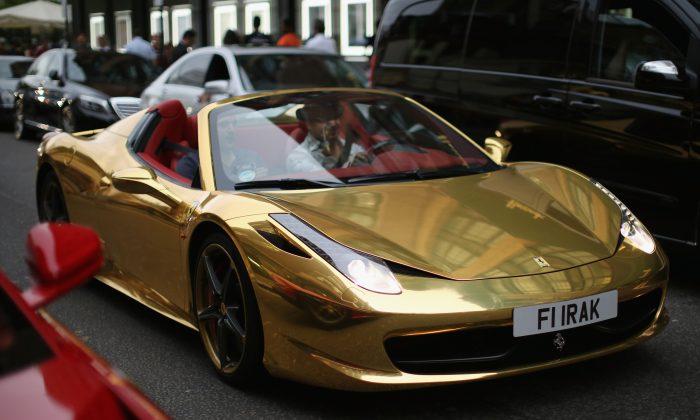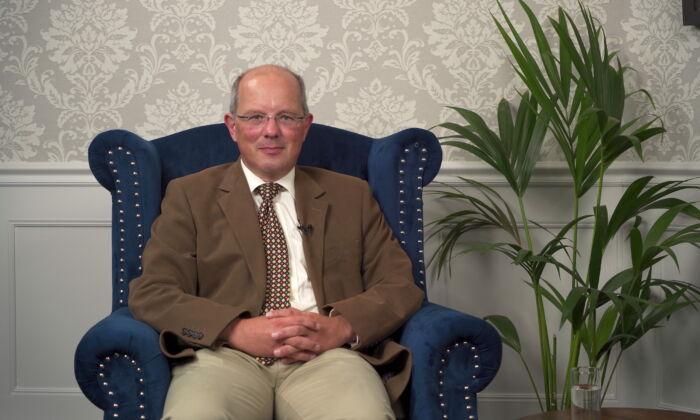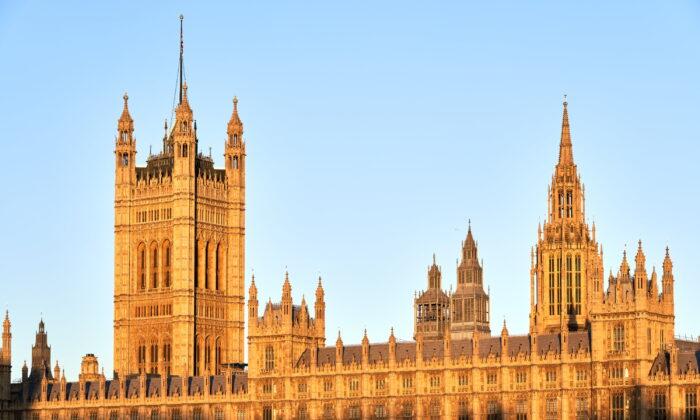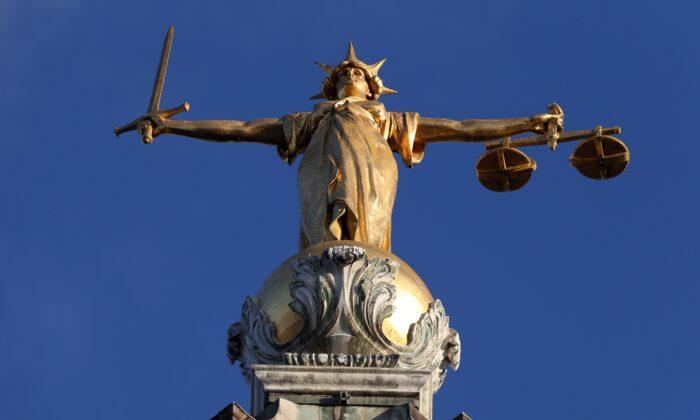LONDON—Where rattling horse-drawn carriages once ferried dukes and earls home on summer nights, now squealing golden Ferraris catapult their flashy owners past crowds of tourists wielding camera phones.
London police this weekend started cracking down on supercar boy racers, using powers typically aimed at anti-social behavior. The issue, however, is just one symptom of how inner London has changed as the established upper class is supplanted by a new breed: the international super-rich.
The city’s most well-heeled streets may have kept their classical facades, private garden squares, and wrought iron balconies, but behind them now lies a modern world of basement multi-gyms, gold-lined swimming pools, and media rooms. The owners are often unseen and unknown, visiting only for a few weeks a year, or cloaking their identity in offshore tax havens.
“There really is a sense that the established British elite are finding it hard to maintain a foothold,” said Roger Burrows, professor of cities at Newcastle University, who has been researching the impact of the influx of foreign capital into central London property. “They can afford 10 million pounds, but they can’t afford 40 million pounds. There is really sense of loss of core areas—of Commonwealth.”
The original residents have been able to cash in on a property boom in which top-tier prices have outstripped the rest of London’s housing market, tripling since 2003 and almost doubling since 2008. But there is an accompanying sense of dislocation and anger that the mega-opulence of brash new money has run roughshod over old money and its sense of refinement and culture.
The aristocratic pedigree of areas such as Knightsbridge is a key selling point to international buyers who want not just homes but also investments.
Some 69 percent of buyers in Knightsbridge were from overseas in 2012, reported international estate agents Savills, with over half of sales in most of the “super-prime” central areas going to overseas buyers. Burrows says that in some prime areas, the foreign ownership is around 80 to 90 percent.
Courting International Capital
Many cities around the world have caught the prevailing winds of international property investment, whipping up house prices and catalyzing gentrification. London, however, is the leader among the handful of cities that have become playgrounds of the super-rich. Compare the various data sets over the last decade—be it number of billionaires, surveys among investors, or number of high net worth individuals—and London sits at the top. New York is a close second.
Following the crash of 2008, investors saw London’s property market as a safe haven, heating up already inflated prices.
“London is still a very appealing and very safe place to park your money. It’s not about occupying, it’s about being able to keep capital. It’s often a trade-off between a house in London and classic cars, or fine wine or art,” said Burrows.
The appeal also lies in its international connections, education, rule of law, and social stability.
Foreign capital has not been lured by London’s natural charms unaided, however, says Burrows. There has been significant match-making.
“It’s been a political strategy to bring international capital to London. It has been encouraged by a particular faction of the British elite.”
Ironically, now those people are being affected directly, he says.
“Peter York [author and respected authority on London’s upper-class society] talks about the aristocracy and the gentry in those areas being more of a butler class, themselves very wealthy people. The function they now play is to introduce culture to the newly wealthy—a butler class who facilitate and who help the transference of capital into London.”
Most super-prime properties can be found in the boroughs of Westminster and Kensington and Chelsea, an area of about 13 square miles at the heart of the city that includes Buckingham Palace and the Houses of Parliament. (Greater London, with a population of over 8 million, covers an area of about 600 square miles.)
Properties in these areas are often occupied for only a few weeks or months a year. A report for Westminster City Council in 2014 estimated occupancy levels at 40 percent.
In total, 10 percent of properties in Westminster and 7 percent in Kensington and Chelsea are owned by companies registered in tax havens, according to official land registry records collated by the Guardian newspaper.
Icebergs and Supercars
In Knightsbridge, a few minutes’ walk from where sharp-suited Bentley drivers wait patiently outside the luxury department store Harrods, and a few blocks from the McLaren and Ferrari showrooms, hiding in a cluster of new restaurants is an old Italian deli, La Picena. The owner says she’s seen the area change dramatically over the last 42 years. “The money went up, but the area went down.” Her customers were once the upper-class English, who she says had manners and formed part of a community.
“Now people are just coming and going, going and coming, and nobody knows who anyone is. Before, we used to see them come in. Now they just send their staff.” Many of those original residents who rented were priced out the area some time ago, she says.
The story is echoed by the owner of a grocery store, established 28 years ago, on the edges of Belgravia, just down the road from Eaton Square. Apartments here, London’s largest and most expensive private garden square, can cost up to 50 million pounds ($63 million). The square is almost empty, except for the odd passing tourist and the builders in bright yellow vests who traipse in and out of the scaffolding-clad buildings that are dotted around the square.
Noisy, large-scale, and lengthy renovations (sometimes one or two years) are just one of the bugbears of local residents. Wealthy buyers, prohibited from building up or out, burrow down several stories, their massive basements reaching not only under the buildings but also under the gardens, creating so-called iceberg properties.
Another typical sticking point is the supercars. Not only does the bling factor grate, so do the midnight revving engines, street racing, and gawping crowds.
For the first time, this summer London police are cracking down on “supercar season,” prepared to target not only drivers but also the spectators who record the antics on their phones. Inspector Chris Downs of the Kensington and Chelsea Community Policing Team said in a statement: “In previous years, there have been a large number of complaints during summer nights—especially at weekends—relating to anti-social behavior and the late night noise nuisance caused by high-powered vehicles being driven in a reckless and aggressive manner.”
Old Money Versus New Money
According to Burrows, the international super-rich show little sensitivity to the established residents who, while they like to keep to themselves, still formed something of a community with shared values.
“If you go to places like Highgate, you see billionaires or Ultra High Net Worth Individuals and they are not interested if people are going to start whining about basements or their over-the-top security,” said Rowland Atkinson, professor of urban studies and planning at Sheffield University, who has researched the super-rich gentrification alongside Burrows.
The Middle Eastern boy racers who get their Lamborghinis flown in for a month, the oligarchs who buy two houses and knock them into one, and the stripping out and commodification of heritage buildings are seen as vulgar and offensive by London’s native upper class.
“This is a sort of two fingers display of opulence.”
Professor Atkinson says that there is a growing clash of cultures. “It’s about old money versus new money, about young people and old people, all kinds of new divisions that are opening.”
The “old rich” don’t share the same relationship with money, he says. “They are not interested in the staggering excesses. There is a feeling that all of this is sort of about greed and raw money and that London was about something more than that, that it also provided a certain social circuit.”
“There are people whose networks are still intact in places like Knightsbridge, but they are just expressing deep anger, occasionally racism. There is a sense of post-Colonial blowback. ‘These people moving here, the temerity.’”
The very same attitudes and issues that appeared within the working class when their areas were gentrified are now being echoed by the upper classes.
The influx of international property investment hasn’t been into just the super-wealthy areas but across the market, with wealthy middle classes around the world buying up rental nest eggs in London. The result has been to further pressure London’s housing crisis, accelerate gentrification, and to lift the bottom rungs of the housing ladder further beyond most of the young aspiring middle class.
With the top of the market going through a post-Brexit wobble, those long shut out of the housing market are watching, hoping to see tumbling prices cascade down to the bottom—something which few analysts predict.
Atkinson and Burrows emphasize that their research shows the hugely disproportionate influence of the relatively low number of super-rich on the city’s economy, society, and policies. The plight of the old British elite—the “super-gentrification” by the super-rich—is not a matter of schadenfreude or empathy, but is indicative of the broader situation, says Atkinson.
“If those [wealthy upper-class] people are being financially and symbolically displaced from the heartlands of empire and center of the city, there is a real problem. It means no one is immune from this.”





